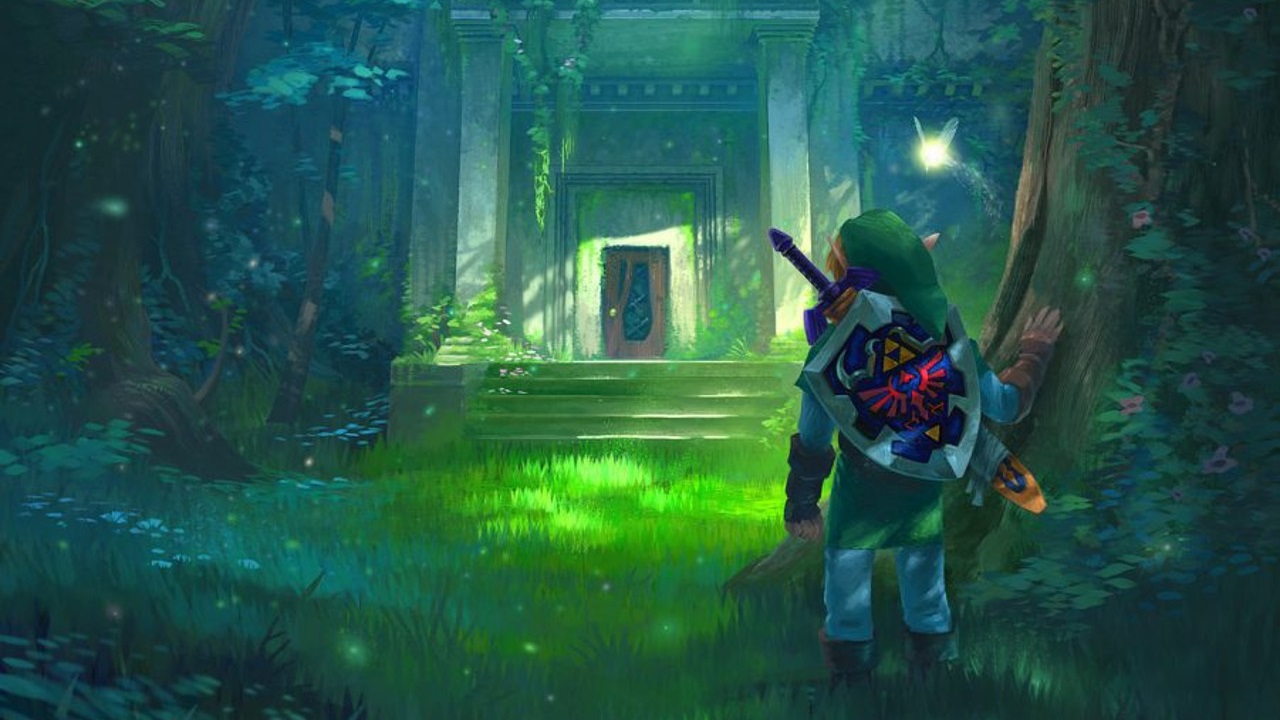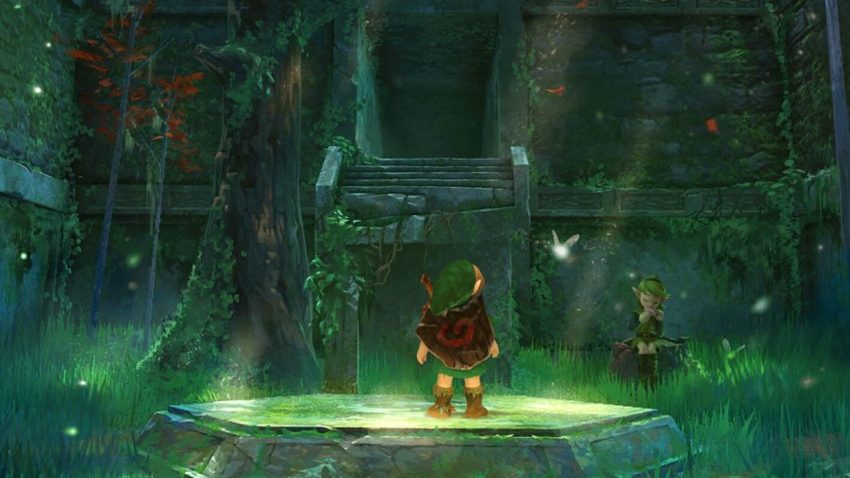The Unforgettable and Unmatched Power of the Forest Temple
Posted on January 28 2023 by Chakell Herbert

Just imagine.
It’s the late 90’s, and you’re just a kid playing through your first ever Zelda game — Ocarina of Time — on the Nintendo 64. For the most part, things haven’t been too difficult! You’ve conquered The Great Deku Tree, snuck past the guards at Hyrule Castle to meet Princess Zelda, received the Goron’s Ruby, and painstakingly carried Princess Ruto through the disgusting depths of Lord Jabu Jabu. And here you are — ready for the next big event this adventure has for you. But then, as you’re approaching Castle Town to give Zelda the news, you notice something. The clouds grow dimmer with each step you take, and you gasp as you see that the drawbridge to the town is closed and the torches are lit — something has gone wrong.
Sure enough, the most dramatic cutscene you’ve ever witnessed thus far in your life ensues. You watch as Princess Zelda desperately flees without saying goodbye, and the huge, terrifying Gerudo King, Ganondorf, whom you have only ever heard about, stands before you, mounting an equally sinister horse. He offers a threat, and a horrifying laugh that most iconic villains would applaud, and rides off to chase the princess down, leaving Link beaten, humiliated, and alone.
When I first reached this point in Ocarina of Time, I was absolutely stunned. I had grown attached to the characters I had met thus far, and had done everything Zelda told me to, and now she was gone, leaving me without much to go on. Everything went wrong. And as soon as I entered the Temple of Time to retrieve the Master Sword and see Link age seven years, I could feel a sense of loss, intimidation, and loneliness in the usually whimsical land of Hyrule I had explored so far.
Unfamiliar Feelings

As soon as I left The Temple of Time, the world I had grow to love was different! The charm and light-heartedness was seemingly fading away with every step as I saw the remains of a massacred Castle Town, a broken draw bridge, a completely corrupted Lon Lon Ranch, and many refugees who were displaced to Kakariko Village. But nothing quite affected me as much as walking into Kokori Forest and seeing Link’s childhood home absolutely changed and tarnished by monsters. And when I played “Saria’s Song” to ask Link’s childhood friend for guidance, she informed me that she was trapped within the Forest Temple and desperately needed help.
The Forest Temple? I thought. Where the heck is the Forest Temple?
I thought I had already explored all there was to see in the forest Link grew up in, but after retrieving the Hookshot and following the hints from Link’s old neighbors, I entered the Lost Woods again, hoping for some sort of clue. I almost died of fright when, deeper into the woods, instead of harmless Deku Scrubs, Moblins patrolled and attacked me from behind in the maze that precedes the Sacred Forest Meadow. However, what was more worrisome was that Saria wasn’t waiting for me on her tree stump when I finally reached it. She really was gone and in some unknown area. Following the brief meeting with Sheik, I knew there had to be some entrance to this Forest Temple everyone kept talking about. (Remember, I was a naive little kid at the time.)
But that’s when I noticed the broken staircase above the stump that seemingly led to nowhere. So I took a stab in the dark and used my new Hookshot, and sure enough, there was a whole new area I didn’t anticipate. It felt like finding a long-lost secret in my own backyard, and it was beyond fascinating! I felt so proud of myself.
Though I had no idea what to expect as I walked toward the next area.
I still remember chills running down my spine the moment the words “Forest Temple” appeared on the screen and I heard the beginnings of the strangest song I had ever heard in a video game. The melody was equally haunting and chilling as it was intriguing. Taking a look at Link’s surroundings, I seemed to be in an old abandoned fortress of some sort, and for the first time in any video game, I felt an inkling of fear.
One thing was for certain: This was unlike any place I had ever been before.
Facing the Real World

The Forest Temple, to me, is the most perfect temple in the entire Zelda franchise. Many future games have tried to topple this iconic dungeon, but to me, it’s unbeatable because of one thing: what it stands for.
Let me explain. Because Link’s journey throughout Ocarina of Time before the Forest Temple hasn’t been excruciatingly difficult, something seems off the moment you step into this dungeon. As it is traditionally the first adult dungeon in the game, you truly feel the terrifying truth settle in as soon as the area fades in and the somber music begins: you’re not a kid anymore, and there is a threat in this fortress that is bigger than anything you’ve tackled before.
Throughout the entire Forest Temple, it feels like you are being watched — like something is hiding in the shadows — stalking you as you navigate its twists and turns (no pun intended). I was truly frightened of this place as a kid. I still remember the heart-pounding fear I felt as I would approach each door and wait for some unspeakable horror to sneak up on me at every turn. I hated it!
But as I’ve gotten older, I’ve realized that the fear, the twists and turns, and the whole shift in mood is the point!
This dungeon isn’t just testing Link’s courage and abilities as the now-age-appropriate Hero of Time — its testing yours as well. Ocarina of Time doesn’t really hold your hand throughout the adventure, but in the childhood half of the game, things are pretty simple and straightforward. However, from the moment you’re in the Forest Temple, you’re sort of just shoved in there with nothing to go on, facing enemies, multiple dead ends, and contraptions you’ve never even come across before. To name a few: falling ceilings, twisting corridors, the creepy Poe Sisters, Stalfos, and a number of puzzles that make you scratch your head. And let’s not forget the intense anxiety you feel when Navi interrupts your movement to give you a sinister warning to, “Watch for the shadows of monsters that hang from the ceiling.”
…Um. What? (I’m still scarred for life from the first time a Wallmaster dragged a screaming Link into the ceiling.)
Then comes the boss. Once you feel like you’ve tackled the whole fortress, you take the elevator you’ve desperately been trying to power up since the beginning, you solve the room-turning puzzle down below, and there’s the first real boss door (complete with a boss key) that you’ve come across in your adventure.
As you enter the weird, chapel-like room, you notice identical paintings on the wall, but no threats have appeared yet.
There has to be a catch, right?
Of course there is! As soon as Link turns around when he tries to leave the circle of paintings, there is Ganondorf, smirking and enjoying every moment of Link’s absolute terror. I think my nine-year-old heart almost stopped beating the first time I saw this. I was not ready to face this guy, right? It had to be a joke! But then when this villain is revealed to be Phantom Ganon — just a shadow of the true antagonist. I felt a surge of courage that I could take him down, and after many, many, many attempts at death tennis, I finally did.
I’ll never forget the chilling foreshadowing words of the real Ganondorf after I defeated his phantom: “When you face the real me, it won’t be so easy.”
Last but not least, you finally have a bittersweet reunion with the person who prompted you to come to this place to begin with: Saria. And just like everyone else you used to know and love, she’s also changed. She has a new purpose to fulfill, and so do you. Whatever childhood romantic feelings you once felt for each other are a thing of a past, unavailable to you — no longer a possibility.
You’ve got no choice but to move on from what once was and grow up.
Pure Perfection

The Forest Temple’s placement in Ocarina of Time‘s story, its increased difficulty, its unmatched atmosphere, and its unforgettable boss that prepares you early on for the real fight with Ganondorf are nothing but perfection. As you explore its musty walls with feelings of abandonment and apprehension, you truly feel like someone who has been completely displaced from all familiarity, has been forced to grow up, and has to figure out what to do next on your own.
Sounds a little bit like facing adulthood in real life, right?
I truly believe the whole execution of the Forest Temple in Ocarina of Time is a powerful metaphor for what it feels like to lose your childhood innocence and see the world beyond the rose-colored glasses you may have worn as a kid. This place tests your response to fear and the terrifying unknown, and does it so brilliantly. I felt a sense shattered innocence deeply and felt like I had to muster actual courage as I played through it the first time as a nine-year-old, and I still feel inklings of those feelings 20 years later through each playthrough.
Yet through it all, once you see Phantom Ganon’s defeat and rescue Saria, you truly feel like you’ve conquered a huge feat. I know when I did, I felt like I could tackle anything else that came my way to the very end of the adventure. The same goes for real life: the biggest and most unfamiliar challenges are the ones that teach you the most and give you hope that you’re resilient and courageous enough to overcome more in the future.
Now that is what you call a dungeon (and an overall game) that continues to stand the test of time. No matter how many Zelda games release or how extravagant new dungeons are, I always find myself coming back to this one, because it’s simply unmatched. Some dungeons in more recent games have gotten close, but I don’t think any will ever evoke the same perfect blend of nostalgia, story-telling, atmosphere, and overall design and execution. I’ll never forget how toppling this dungeon was the first time I truly understood what it means to be brave, which is why it will always be my all-time favorite.
Featured Art: Forest Temple art by Tom Garden, Sacred Forest Meadow by Tom Garden, Entrance to Kokiri Forest by Tom Garden, Kokiri Forest by Tom Garden

Chakell (pronounced shuh-kell) is an associate editor for Zelda Dungeon! She has loved The Legend of Zelda series since she was a little girl because of its equal mix of princesses, besting bad guys, and heartfelt stories. Chakell lives in the overall tame state of Utah, but holds onto her childhood hopes to find an adventure in her backyard one day. She has a degree in English and is a full-time editor for a magazine. You can usually find her gaming (obviously), laughing with her husband, taking a long time to tell stories because she keeps getting distracted; getting sucked into books and podcasts; or snuggling her cute Cavalier King Charles Spaniel.



